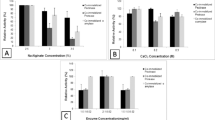Abstract
In this work, we report the preparation of bacterial cellulose (BC)-chitosan composite hydrogel beads by co-dissolution of BC and chitosan in 1-ethyl-3-methylimidazolium acetate and subsequent reconstitution with distilled water. The BC-chitosan hydrogel beads were used as enzyme supports for immobilizing Candida rugosa lipase by physical adsorption and covalent cross-linking. BC-chitosan hydrogel beads immobilized lipase more efficiently than microcrystalline cellulose (MCC)-chitosan hydrogel beads. The amount of protein adsorbed onto BCchitosan beads was 3.9 times higher than that adsorbed onto MCC-chitosan beads, and the catalytic activity of lipase was 1.9 times higher on the BC-chitosan beads. The lipase showed the highest thermal and operational stability when covalently cross-linked on BC-chitosan hydrogel beads. The half-life time of the lipase cross-linked on BC-chitosan bead at 60°C was 22.7 times higher than that of free lipase. Owing to their inherent biocompatibility and biodegradability, the BC-chitosan composite hydrogel beads described here could be used to immobilize proteins for various biomedical, environmental, and biocatalytic applications.
Similar content being viewed by others
References
Iguchi, M., S. Yamanaka, and A. Budhiono (2000) Bacterial cellulose-a masterpiece of nature's arts. J. Mater. Sci. 35: 261–270.
Kim, Y. H., S. Park, K. Won, H. J. Kim, and S. H. Lee (2013) Bacterial cellulose-carbon nanotube composite as a biocompatible electrode for the direct electron transfer of glucose oxidase. J. Chem. Technol. Biotechnol. 88: 1067–1070.
Akduman, B., M. Uygun, E. P. Coban, D. A. Uygun, H. Biyik, and S. Akgol (2013) Reversible immobilization of urease by using bacterial cellulose nanofibers. Appl. Biochem. Biotechnol. 171: 2285–2294.
Frazao, C. J. R., N. H. C. Silva, C. S. R. Freire, A. J. D. Silvestre, A. M. R. B. Xavier, and A. P. M. Tavares (2014) Bacterial cellulose as carrier for immobilization of laccase: Optimization and characterization. Eng. Life Sci. 14: 500–508.
Yao, W. Y., X. Wu, J. Zhu, B. Sun, and C. Miller (2013) In vitro enzymatic conversion of ?-aminobutyric acid immobilization of glutamate decarboxylase with bacterial cellulose membrane and non-linear model establishment. Enz. Microb. Technol. 52: 258–264.
Shah, N., M. Ul-Islam, W. A. Khattak, and J. K. Park (2013) Overview of bacterial cellulose composites: A multipurpose advanced material. Carbohydr. Polym. 98: 1585–1598.
Schlufter, K., H. P. Schmauder, S. Dorn, and T. Heinze (2006) Efficient homogeneous chemical modification of bacterial cellulose in the ionic liquid 1-N-butyl-3-methylimidazolium chloride. Macromol. Rapid Commun. 27: 1670–1676.
Okushita, K., K. E. Chikayama, and J. Kikuchi (2012) Solubilization mechanism and characterization of the structural change of bacterial cellulose in regenerated states through ionic liquid treatment. Biomacromol. 13: 1323–1330.
Sun, X., B. Peng, Y. Ji, J. Chen, and D. Li (2009) Chitosan(chitin)/ cellulose composite biosorbents prepared using ionic liquid for heavy metal ions adsorption. AIChE J. 5: 2062–2069.
Park, T. J., Y. J. Jung, S. W. Choi, H. Park, H. Kim, E. Kim, S. H. Lee, and J. H. Kim (2011) Native chitosan/cellulose composite fibers from an ionic liquid via electrospinning. Macromol. Res. 19: 213–215.
Stefanescu, C., H. W. Daly, and I. I. Negulescu (2012) Biocomposite films prepared from ionic liquid solutions of chitosan and cellulose. Carbohydr. Polym. 87: 435–443.
Kim, M. H., S. An, K. Won, H. J. Kim, and S. H. Lee (2012) Entrapment of enzymes into cellulose-biopolymer composite hydrogel beads using biocompatible ionic liquid. J. Mol. Catal. B: Enz. 75: 68–72.
Peng, S., H. C. Meng, L. Zhou, and J. Chang (2014) Synthesis of novel magnetic cellulose-chitosan composite microspheres and their application in laccase immobilization. J. Nanosci. Nanotechnol. 14: 7010–7014.
Shanshan, G., W. Jianqing, and J. Zhengwei (2012) Preparation of cellulose films from solution of bacterial cellulose in NMMO. Carbohydr. Polym. 87: 1020–1025.
Zhang, D. H., L. X. Yuwen, C. Li, and Y. Q. Li (2012) Effect of poly(vinyl acetate-acrylamide) microspheres properties and steric hindrance on the immobilization of Candida rugosa lipase. Bioresour. Technol. 124: 233–236.
Author information
Authors and Affiliations
Corresponding author
Rights and permissions
About this article
Cite this article
Kim, H.J., Jin, J.N., Kan, E. et al. Bacterial cellulose-chitosan composite hydrogel beads for enzyme immobilization. Biotechnol Bioproc E 22, 89–94 (2017). https://doi.org/10.1007/s12257-016-0381-4
Received:
Revised:
Accepted:
Published:
Issue Date:
DOI: https://doi.org/10.1007/s12257-016-0381-4




